Washing and Abrasion Resistance of Textile Electrodes for ECG Measurements
Abstract
:1. Introduction
2. Materials and Methods
- -
- Conductive sewing only (Figure 1a): cutting an electrode substrate from cotton, sewing the borders with non-conductive yarn to avoid unraveling, sewing three lines of backstitch + zigzag stitch, as described above.
- -
- Conductive sewing followed by PEDOT:PSS coating (Figure 1b): starting with the aforedescribed electrode with conductive sewing → dipcoating with as-purchased PEDOT:PSS → 4 h at 60 °C.
- -
- Conductive sewing followed by Powersil coating (Figure 1c): starting with the aforedescribed electrode with conductive sewing → mixing components A and B of Powersil in a ratio of 1:1 → coating the electrodes using a doctor’s blade → polymerization for 2 h at 200 °C.
3. Results and Discussion
4. Conclusions
Author Contributions
Funding
Institutional Review Board Statement
Informed Consent Statement
Data Availability Statement
Conflicts of Interest
References
- Ishijima, M. Cardiopulmonary monitoring by textile electrodes without subject-awareness of being monitored. Med. Biol. Eng. Comput. 1997, 35, 685–690. [Google Scholar] [CrossRef]
- Soroudi, A.; Hernández, N.; Wipenmyr, J.; Nierstrasz, V. Surface modification of textile electrodes to improve electrocardiography signals in wearable smart garment. J. Mater. Sci. Mater. Electron. 2019, 30, 16666–16675. [Google Scholar] [CrossRef]
- Vidhya, C.M.; Maithani, Y.; Singh, J.P. Recent Advances and Challenges in Textile Electrodes for Wearable Biopotential Signal Monitoring: A Comprehensive Review. Biosensors 2023, 13, 679. [Google Scholar] [CrossRef]
- Ritchie, H.; Roser, M. Causes of Death. Our World in Data 2018. Available online: https://ourworldindata.org/causes-of-death (accessed on 1 August 2023).
- Ahmad, F.B.; Anderson, R.N. The leading causes of death in the US for 2020. JAMA 2021, 325, 1829–1830. [Google Scholar] [CrossRef] [PubMed]
- Breen, C.J.; Kelly, G.P.; Kernohan, W.G. ECG interpretation skill acquisition: A review of learning, teaching and assessment. J. Electrocardiol. 2022, 73, 125–128. [Google Scholar] [CrossRef]
- Trummer, S.; Ehrmann, A.; Büsgen, A. Development of underwear with integrated 12 channel ECG for men and women. AUTEX Res. J. 2017, 17, 344–349. [Google Scholar] [CrossRef]
- Bouwstra, S.; Chen, W.; Bambang Oetomo, S.; Feijs, L.M.G.; Cluitmans, P.J.M. Designing for reliable textile neonatal ECG monitoring using multi-sensor recordings. In Proceedings of the 2011 Annual International Conference of the IEEE Engineering in Medicine and Biology Society, Boston, MA, USA, 30 August–3 September 2011; pp. 2488–2491. [Google Scholar] [CrossRef]
- Fobelets, K.; Hammour, G.; Thielemans, K. Knitted ECG Electrodes in Relaxed Fitting Garments. IEEE Sens. J. 2023, 23, 5263–5269. [Google Scholar] [CrossRef]
- An, X.; Stylios, G.K. A hybrid textile electrode for electrocardiogram (ECG) measurement and motion tracking. Materials 2018, 11, 1887. [Google Scholar] [CrossRef] [PubMed]
- An, X.; Tangsirinaruenart, O.; Stylios, G.K. Investigating the performance of dry textile electrodes for wearable end-uses. J. Text. Inst. 2019, 110, 151–158. [Google Scholar] [CrossRef]
- Nigusse, A.B.; Malengier, B.; Mengistie, D.A.; Tseghai, G.B.; van Langenhove, L. Development of Washable Silver Printed Textile Electrodes for Long-Term ECG Monitoring. Sensors 2020, 20, 6233. [Google Scholar] [CrossRef]
- Euler, L.; Guo, L.; Persson, N.-K. Textile Electrodes: Influence of Knitting Construction and Pressure on the Contact Impedance. Sensors 2021, 21, 1578. [Google Scholar] [CrossRef]
- Ravichandran, V.; Ciesielska-Wrobel, I.; Rumon, M.A.; Solanki, D.; Mankodiva, K. Characterizing the Impedance Properties of Dry E-Textile Electrodes Based on Contact Force and Perspiration. Biosensors 2023, 13, 728. [Google Scholar] [CrossRef] [PubMed]
- Ankhili, A.; Tao, X.Y.; Cochrane, C.; Koncar, V.; Coulon, D.; Tarlet, J.-M. Ambulatory Evaluation of ECG Signals Obtained Using Washable Textile-Based Electrodes Made with Chemically Modified PEDOT:PSS. Sensors 2019, 19, 416. [Google Scholar] [CrossRef] [PubMed]
- Shathi, M.A.; Chen, M.Z.; Khoso, N.A.; Rahman, M.T.; Thattacharjee, B. Graphene coated textile based highly flexible and washable sports bra for human health monitoring. Mater. Des. 2020, 193, 108792. [Google Scholar] [CrossRef]
- Babusiak, B.; Borik, S.; Balogova, L. Textile electrodes in capacitive signal sensing applications. Measurement 2018, 114, 69–77. [Google Scholar] [CrossRef]
- Fink, P.L.; Sayem, A.S.M.; Teay, S.H.; Ahmad, F.; Shahariar, H.; Albarbar, A. Development and wearer trial of ECG-garment with textile-based dry electrodes. Sens. Actuators A Phys. 2021, 328, 112784. [Google Scholar] [CrossRef]
- Tuvshinbayar, K.; Ehrmann, G.; Ehrmann, A. 50/60 Hz Power Grid Noise as a Skin Contact Measure of Textile ECG Electrodes. Textiles 2022, 2, 265–274. [Google Scholar] [CrossRef]
- Ankhili, A.; Tao, X.Y.; Cochrane, C.; Coulon, D.; Koncar, V. Washable and Reliable Textile Electrodes Embedded into Underwear Fabric for Electrocardiography (ECG) Monitoring. Materials 2018, 11, 256. [Google Scholar] [CrossRef]
- Arquilla, K.; Webb, A.K.; Anderson, A.P. Textile Electrocardiogram (ECG) Electrodes for Wearable Health Monitoring. Sensors 2020, 20, 1013. [Google Scholar] [CrossRef]
- Wang, L.; Pan, Y.L.; He, D.D.; Qian, L.Y.; Cao, X.H.; He, B.H.; Li, J.R. Conductive Polyester Fabrics with High Washability as Electrocardiogram Textile Electrodes. ACS Appl. Polym. Mater. 2022, 4, 1440–1447. [Google Scholar] [CrossRef]
- Meding, J.T.; Tuvshinbayar, K.; Döpke, C.; Tamoue, F. Textile electrodes for bioimpedance measuring. Commun. Dev. Assem. Text. Prod. 2021, 2, 49–60. [Google Scholar] [CrossRef]
- Schäl, P.; Juhász Junger, I.; Grimmelsmann, N.; Meissner, H.; Ehrmann, A. Washing and Abrasion Resistance of Conductive Coatings for Vital Sensors. In Narrow and Smart Textiles; Kyosev, Y., Mahltig, B., Schwarz-Pfeiffer, A., Eds.; Springer: Cham, Switzerland, 2017; pp. 241–250. [Google Scholar] [CrossRef]
- Jiang, S.; Stange, O.; Bätcke, F.O.; Sultanova, S.; Sabantina, L. Applications of Smart Clothing—A Brief Overview. Commun. Dev. Assem. Text. Prod. 2021, 2, 123–140. [Google Scholar] [CrossRef]
- ISO 12947-1:1998; Textiles–Determination of the Abrasion Resistance of Fabrics by the Martindale Method-Part 1: Martindale Abrasion Testing Apparatus (ISO 12947-1:1998+Cor. 1:2002). ISO Publishing: Geneve, Switzerland, 2002.
- Sparkfun/AD8232_Heart_Rate_Monitor. Available online: https://github.com/sparkfun/AD8232_Heart_Rate_Monitor (accessed on 5 August 2023).
- Uz Zaman, S.; Tao, X.Y.; Cochrane, C.; Koncar, V. Understanding the Washing Damage to Textile ECG Dry Skin Electrodes, Embroidered and Fabric-Based; set up of Equivalent Laboratory Tests. Sensors 2020, 20, 1272. [Google Scholar] [CrossRef] [PubMed]
- Xu, X.W.; Luo, M.; He, P.; Guo, X.J.; Yang, J.L. Screen printed graphene electrodes on textile for wearable electrocardiogram monitoring. Appl. Phys. A 2019, 125, 714. [Google Scholar] [CrossRef]
- Le, K.; Servati, A.; Soltanian, S.; Servati, P.; Ko, F. Performance and Signal Quality Analysis of Electrocardiogram Textile Electrodes for Smart Apparel Applications. Front. Electron. 2021, 2, 685264. [Google Scholar] [CrossRef]
- Tseghai, G.B.; Malengier, B.; Fante, K.A.; Nigusse, A.B.; Etana, B.B.; van Langenhove, L. PEDOT:PSS/PDMS-coated cotton fabric for ECG electrode. In Proceedings of the 2020 IEEE International Conference on Flexible and Printable Sensors and Systems (FLEPS), Manchester, UK, 16–19 August 2020; pp. 1–4. [Google Scholar] [CrossRef]
- Shathi, M.A.; Minzhi, C.; Khoso, N.A.; Deb, H.; Ahmed, A.; Sai, W.S. All organic graphene oxide and Poly (3,4-ethylene dioxythiophene)-Poly (styrene sulfonate) coated knitted textile fabrics for wearable electrocardiography (ECG) monitoring. Synth. Met. 2020, 263, 116329. [Google Scholar] [CrossRef]
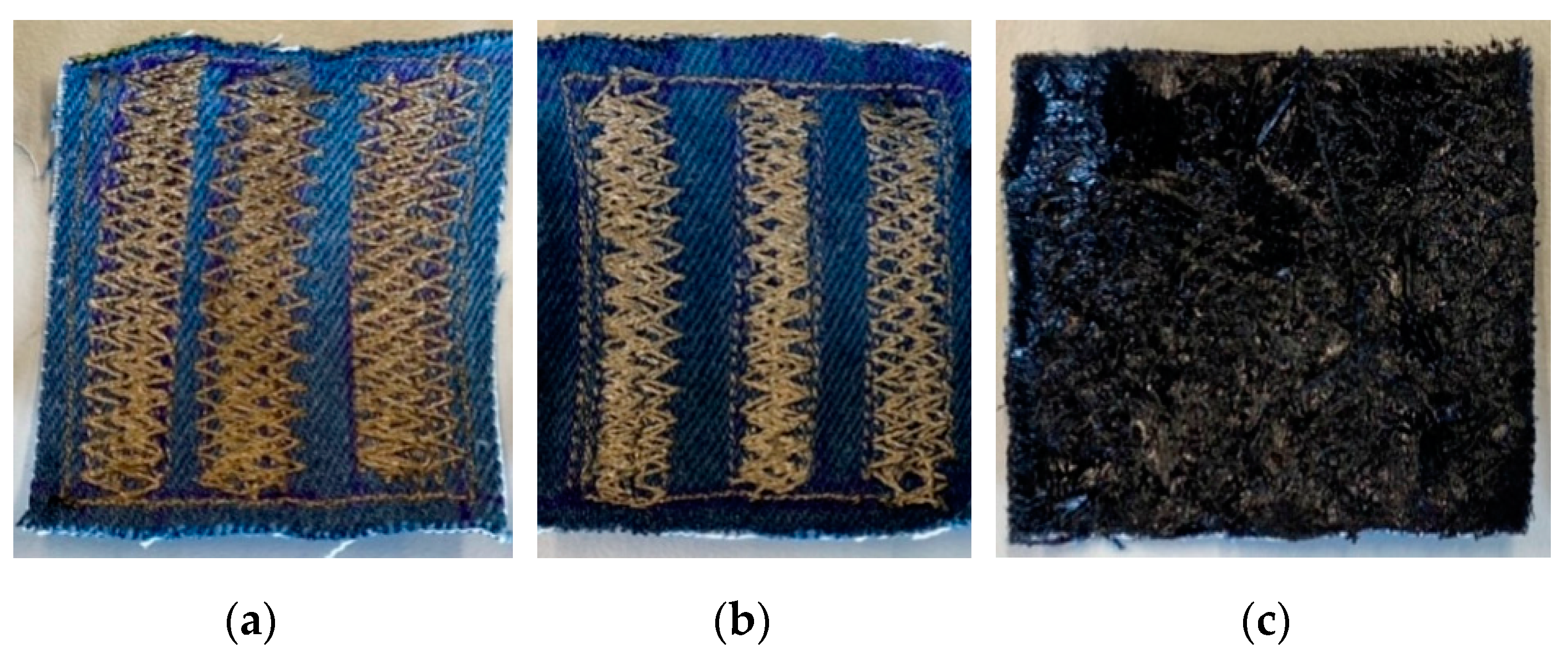

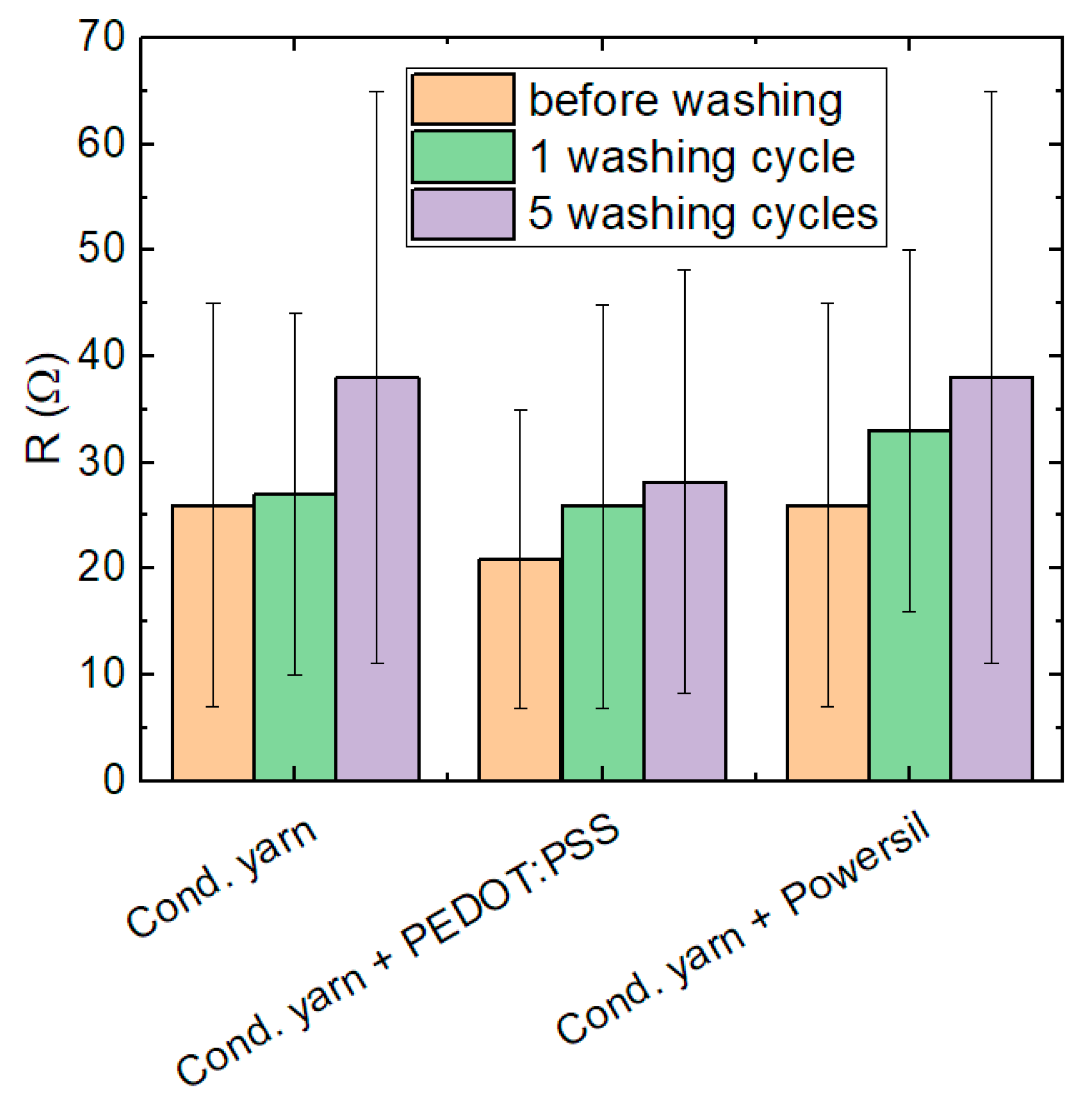
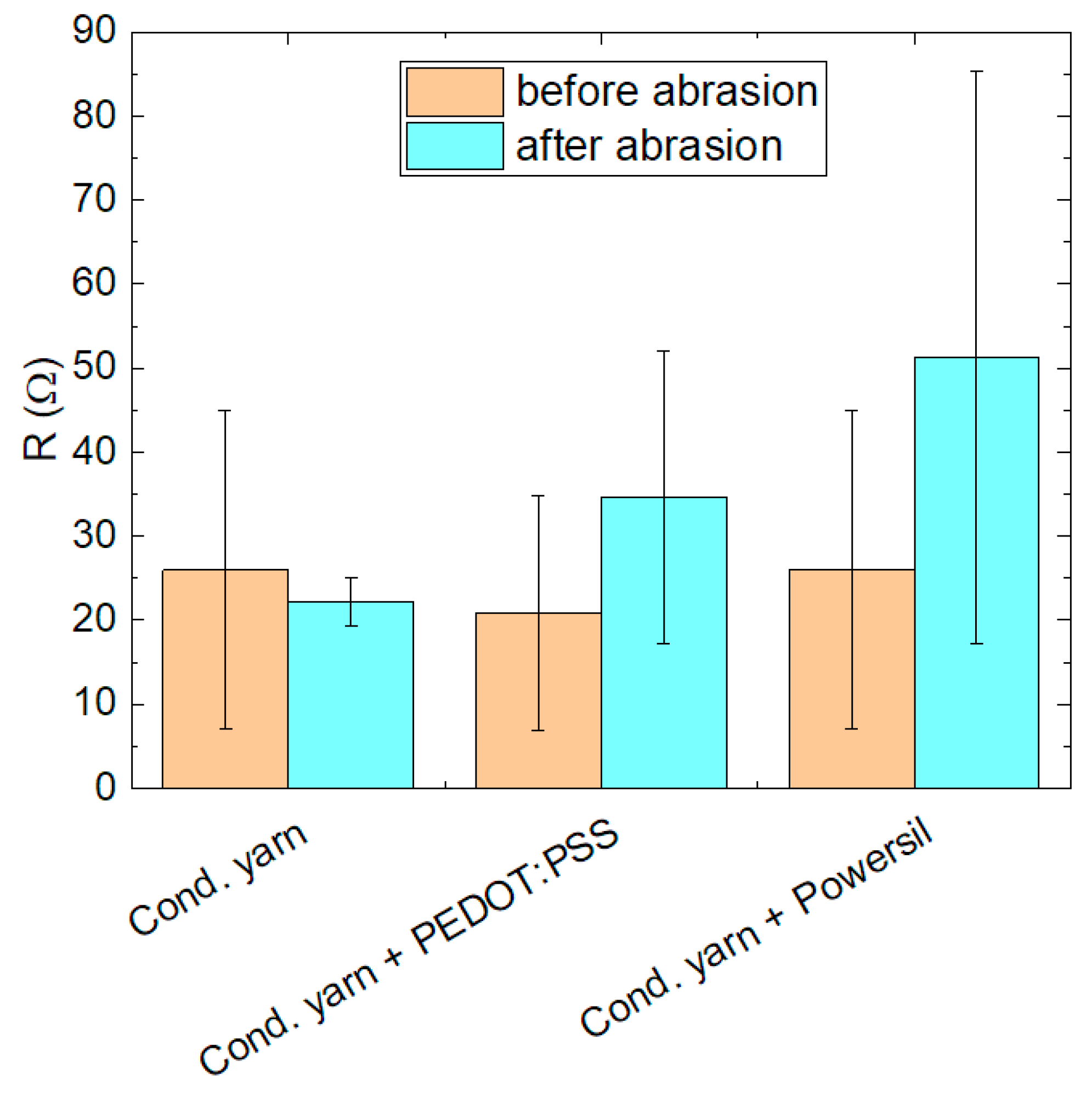
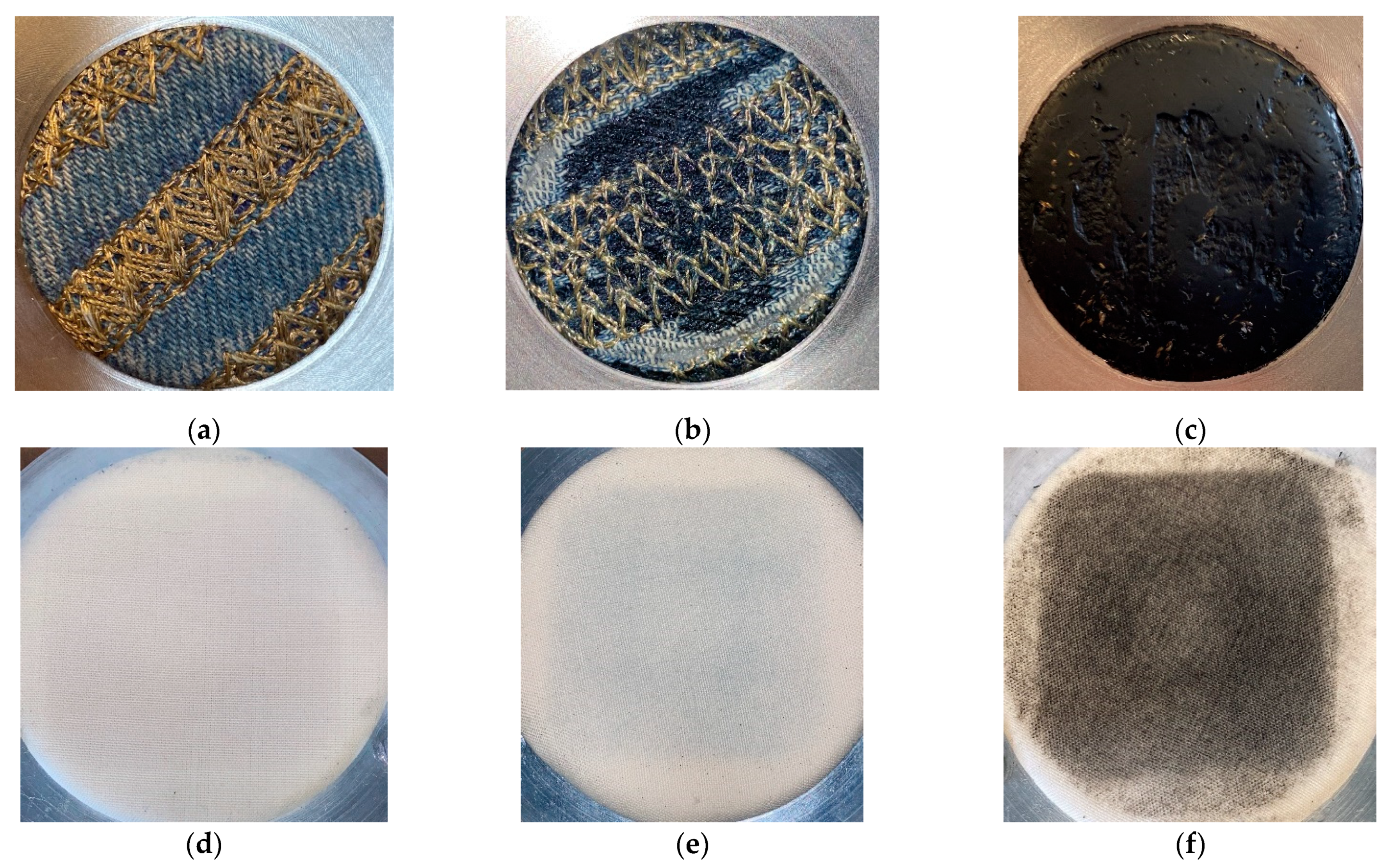
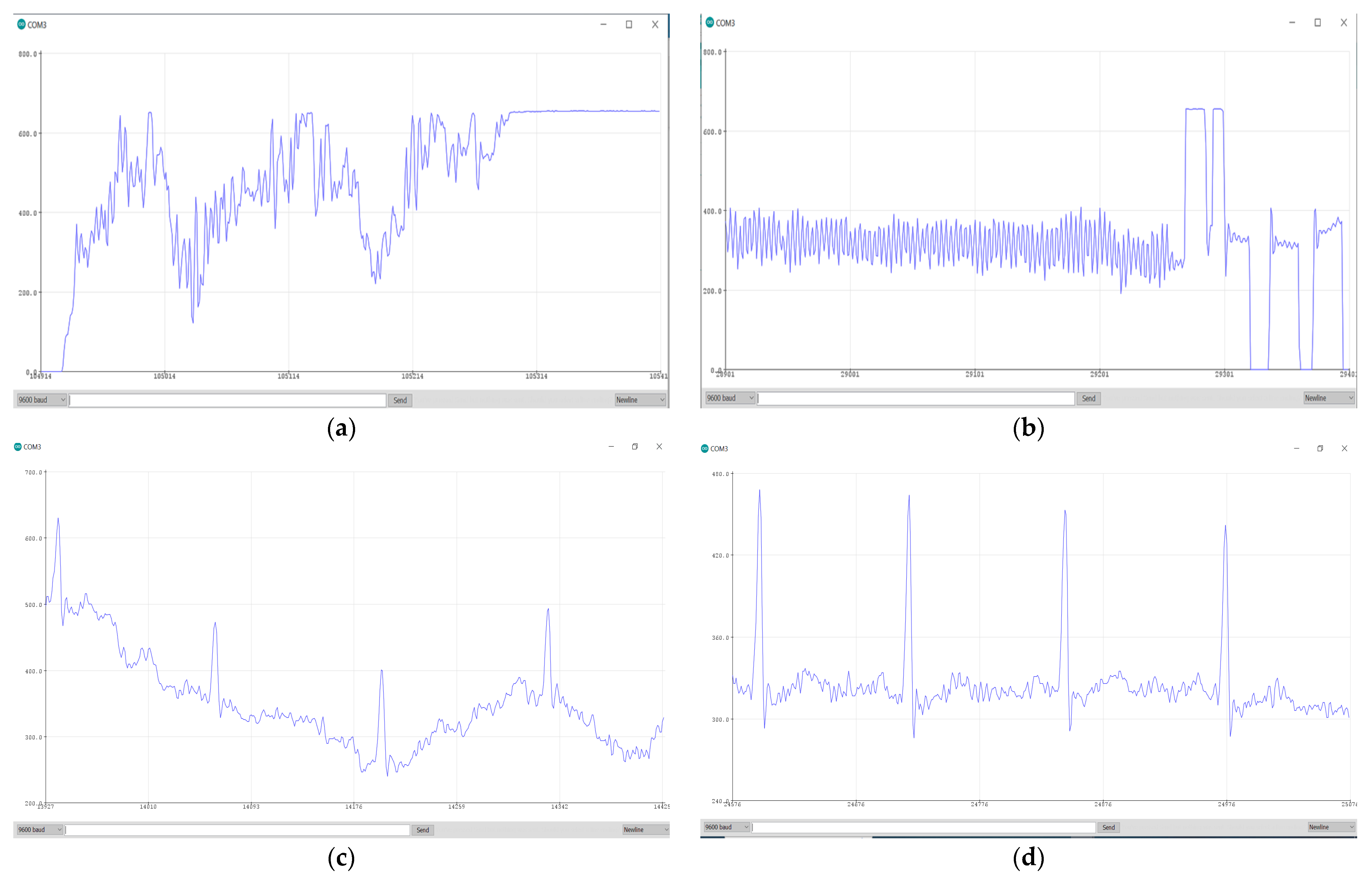
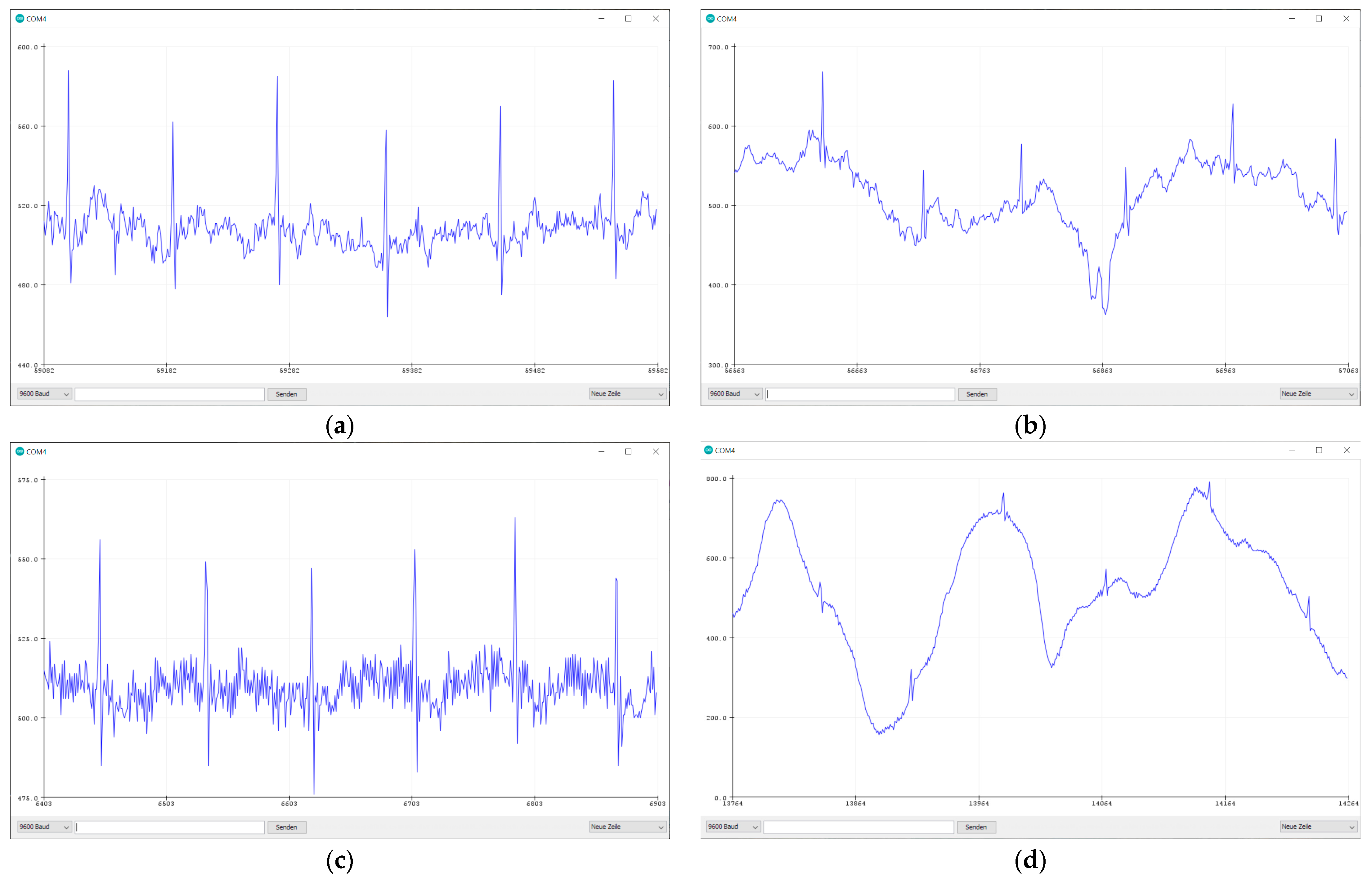

| Textile Structure | Conductive Materials | Sheet Resistance/Ω | Main Features | Test Conditions | Reference |
|---|---|---|---|---|---|
| Woven | Copper/copper nickel coating | 0.04 | Washing impossible | Notch filter + bandpass filter, probands rested before tests | [28] |
| Knitted | Silver-plated | 0.3–1.5 | Washing possible | [28] | |
| Knitted | Screen-printed silver ink | 1.6–1.8 | Pressure dependent signal | Commercial ECG device, probands rested before tests | [12] |
| Woven | Screen-printed graphene | 42 | Bending-resistant | Pre-amplifier, filter, post-amplifier | [29] |
| Warp-knitted | Silver-plated | 0.1–1.7 | Lower signal height than with gel electrodes | Clinical 1-lead ECG system | [30] |
| Woven | PEDOT:PSS screen printing | 330 | Signal similar to gel electrodes | Static measurement | [31] |
| Woven | Graphene oxide dyeing by followed by PEDOT:PSS coating | 50 × 10³ | Similar to medical electrode | Clinical ECG monitor, tested during running | [16] |
| Knitted | Reduced graphene oxide and PEDOT:PSS coating | 140 × 10³ | Measured at the wrist joints | Clinical ECG monitor | [32] |
| Woven | Silver-coated yarn with Powersil-coating | 20–30 | Washing possible, lower motion artifacts than gel electrodes | Low-cost system without filters | This work |
Disclaimer/Publisher’s Note: The statements, opinions and data contained in all publications are solely those of the individual author(s) and contributor(s) and not of MDPI and/or the editor(s). MDPI and/or the editor(s) disclaim responsibility for any injury to people or property resulting from any ideas, methods, instructions or products referred to in the content. |
© 2023 by the authors. Licensee MDPI, Basel, Switzerland. This article is an open access article distributed under the terms and conditions of the Creative Commons Attribution (CC BY) license (https://creativecommons.org/licenses/by/4.0/).
Share and Cite
Doci, D.; Ademi, M.; Tuvshinbayar, K.; Richter, N.; Ehrmann, G.; Spahiu, T.; Ehrmann, A. Washing and Abrasion Resistance of Textile Electrodes for ECG Measurements. Coatings 2023, 13, 1624. https://doi.org/10.3390/coatings13091624
Doci D, Ademi M, Tuvshinbayar K, Richter N, Ehrmann G, Spahiu T, Ehrmann A. Washing and Abrasion Resistance of Textile Electrodes for ECG Measurements. Coatings. 2023; 13(9):1624. https://doi.org/10.3390/coatings13091624
Chicago/Turabian StyleDoci, Dajana, Melisa Ademi, Khorolsuren Tuvshinbayar, Niclas Richter, Guido Ehrmann, Tatjana Spahiu, and Andrea Ehrmann. 2023. "Washing and Abrasion Resistance of Textile Electrodes for ECG Measurements" Coatings 13, no. 9: 1624. https://doi.org/10.3390/coatings13091624
APA StyleDoci, D., Ademi, M., Tuvshinbayar, K., Richter, N., Ehrmann, G., Spahiu, T., & Ehrmann, A. (2023). Washing and Abrasion Resistance of Textile Electrodes for ECG Measurements. Coatings, 13(9), 1624. https://doi.org/10.3390/coatings13091624









